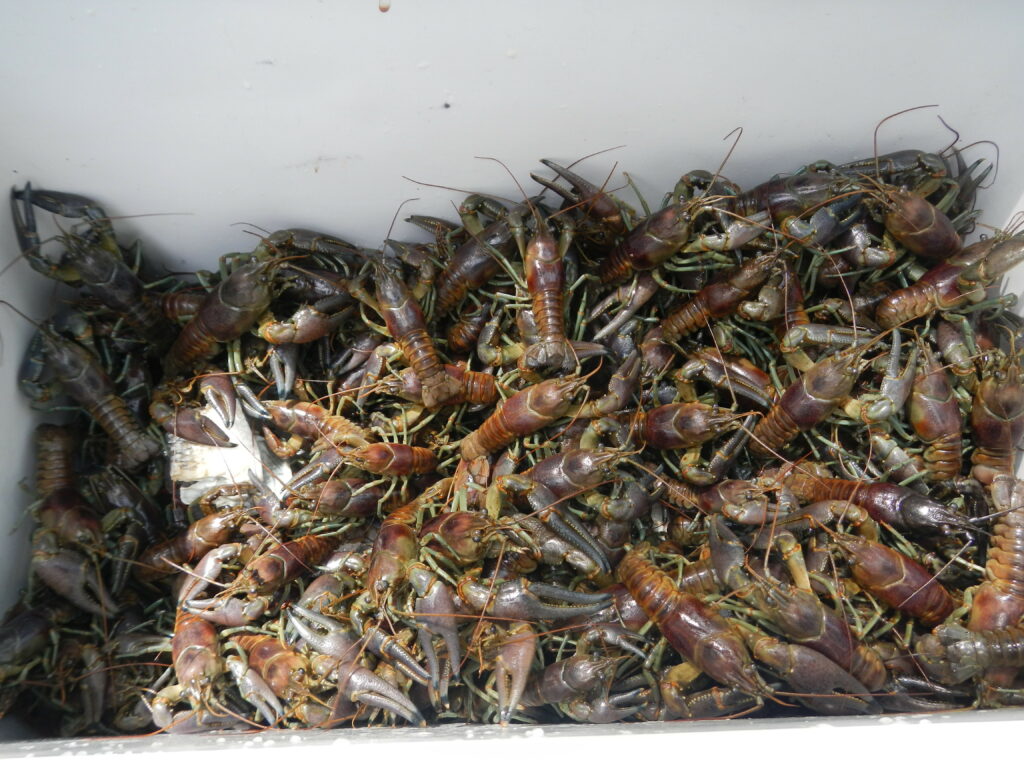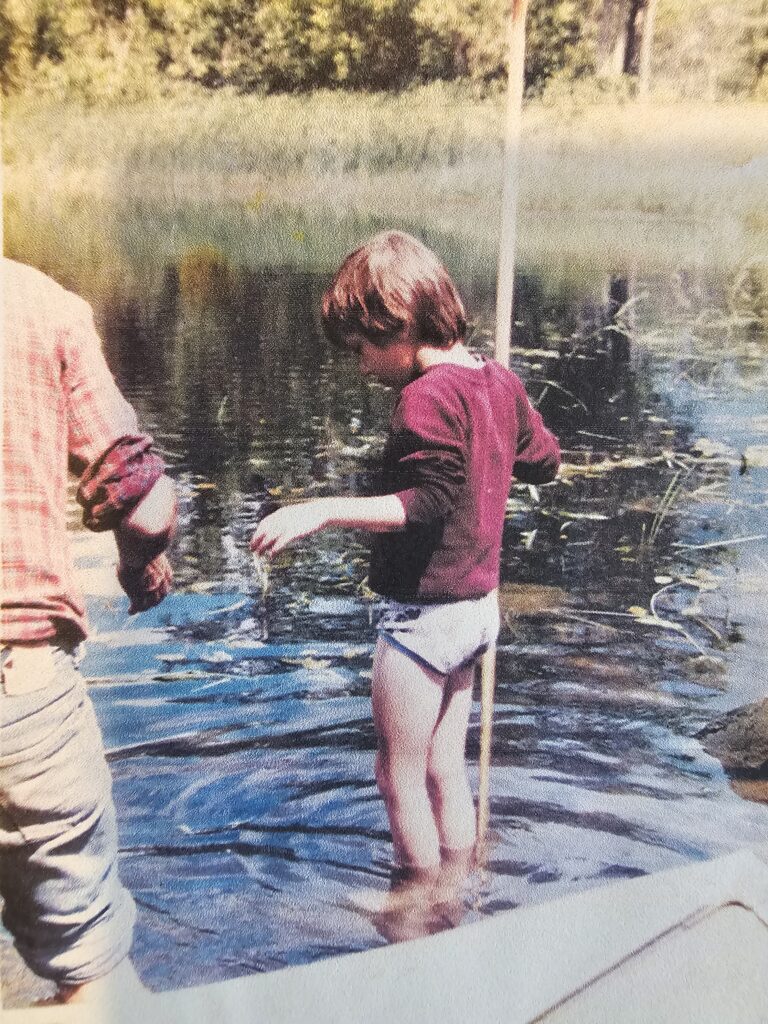Yusef Orest of Grand Marais has had a lifelong fascination with crayfish. At just six years old, his mother has photos of him proudly holding crayfish he’d caught from a northern Minnesota lake. Now, as the owner of Crawdaddies MN, he’s using his childhood passion to create a locally sourced food system and combat the effects of a pernicious invasive species in area waters.
Faxonius rusticus is known as a rusty crayfish. We’ll call them Rusty.
Rusty is a regulated invasive species in Minnesota, which means possessing, selling, buying, and transporting them is legal. Once trapped or caught, Rusty must not be transferred back into public waters.
Rusty is native to the Ohio River Valley and made his debut appearance in northland lakes almost 20 years ago, possibly brought to the area as bait or released by aquarium owners who released their livestock in a local water body.
Amanda Weberg, the Aquatic Invasive Species (AIS) Supervisor with the Cook County Soil & Water District, has been instrumental in the fight against Rusty. She reports that Rusty has been found in several lakes in Cook County, with Pike Lake being a particularly affected area where Rusty caused significant damage to the ecosystem.
One day, three years ago, Orest and his friend Garrett Lima were fishing and gathering crayfish for personal use on Pike Lake. As they were leaving the lake, they saw a large commercial trapping boat coming into Pike to collect crayfish.

As often happens with entrepreneurs, Orest and Lima got the idea that by trapping Rustys and selling them locally, their population could be controlled and they could create a job or two. This initiative not only helps the environment but also creates opportunities for the local community. “Our Crawdaddies MN project was born out of that chance meeting,” Orest said. The success of this project is a beacon of hope for the future.
Since then, Orest has overseen the creation of a system to harvest and distribute living crayfish.
Weberg said anecdotal evidence shows that commercial harvesting of Rusty in Pike Lake has made noticeable improvement over the last three years. This success story is a testament to the potential of sustainable solutions, inspiring and motivating us to continue our efforts. Some areas of vegetation have returned, sport fishing has improved, and three loon pairs and their chicks have survived this summer.
Orest is an energetic and outgoing 44-year-old Mitsubishi Electric Power Products project manager. Working from his home near Grand Marais, he delivers high-level software for utility organizations around the world.
He was born in California and raised on a western Minnesota farm where his parents moved in the 1980s. A long-time Northern Wilds visitor, Orest and his wife Andrea moved to Cook County in 2016 when he accepted a job with Arrowhead Electric in Lutsen. Andrea works as an educator with Cook County Public Health.
Both Orests get involved in various community-related activities in their spare time. “Community involvement makes the world a better place,” Orest said. He is hoping the crayfish harvesting business improves the world, too. This sense of community involvement is what makes this project truly impactful and inclusive.
The Orest family includes four children: Mason, 25; Kian, 12; Eldan, 10; and Rowan, 7.
Kian is Orest’s full-time boat operator, helper, and partner at Crawdaddies MN. Lima has moved on to other interests.
Rusty is an opportunistic species of crayfish that eventually moves further into the watershed. From Pike Lake, where Rusty mostly wiped out native crayfish, it migrated down Murmur Creek, into Bigsby Lake, and ultimately into Caribou Lake.
The Minnesota Department of Natural Resources licenses Crawdaddies MN to harvest, transport, and sell live crayfish. After two years on Pike Lake, its operation is now focused on Caribou Lake, where Kian and Orest can be found daily, checking their DNR-approved traps, harvesting Rustys, and rebaiting the traps. The traps are set over approximately 100 feet of the lake surface, marked and supported by buoys designated by DNR. As traps are recovered, any minnows or fish, as well as native crayfish that have been trapped are returned to the lake. Rustys are all he takes.
The bait, a result of experiments Orest conducts on an ongoing basis, includes a mix of dry cat food and dead minnows donated by Buck’s Hardware, a purveyor of live fishing bait in Grand Marais.
You should make sure crayfish are purged before cooking. Purging cleanses its digestive tract to remove impurities like mud, grass, and other debris to improve taste before cooking. Orest has developed a clean water system that keeps Rusty alive for far longer than the 12-24 hours needed to complete the purge. The process allows Rusty to expel waste from their bodies naturally.
In Minnesota, licensed anglers may collect any crayfish for use as bait on the same water body. They may harvest up to 25 pounds of any crayfish for personal consumption. A person must first obtain a permit from the DNR to possess more than 25 pounds of live, whole, freshwater crawfish. Selling live crayfish for bait or aquarium use is illegal.
Orest credits the people and organizations in Cook County and beyond that have supported Crawdaddies MN. He acknowledges the support he has received from the AIS Supervisor at the Soil and Water District.
“Three years ago, we were talking about the crayfish challenge,” Weberg said. “He said, ‘How can I help?’ and the pilot project began on Pike.”
The County Soil and Water District worked with the Regional Sustainable Development Partnership to help Orest earn grant money to help purchase equipment.
“I want to tip my hat to Elliott and Jessy at Angry Trout and Parker at Fisherman’s Daughter,” Orest said. Both Grand Marais restaurants feature Orest harvested and purged Rustys on their menu board.
Up Yonder and Voyageur Brewing in Grand Marais have hosted crayfish boils featuring locally sourced crayfish. These events are designed to introduce crayfish to the diet of residents who need to be more accustomed to thinking of the crustacean as real food.
Orest created an informational card to help novices learn how to eat and enjoy crayfish.
Once a population of rusty crayfish is established, it is difficult to remove it. Chemicals affect native crayfish and cannot be used.
According to the Wisconsin DNR, scattered success stories exist where trapping like Orest’s and the encouragement of native predators (bass and sunfish) have been able to restore a natural balance to some lakes.
Preventing the spread of Rusty to other watersheds is the best way to control it.

